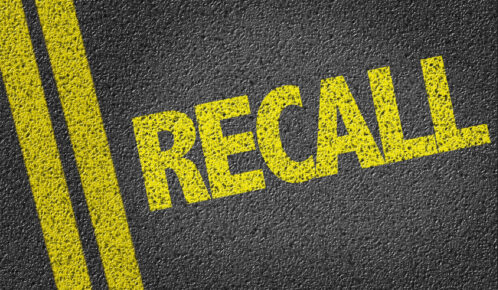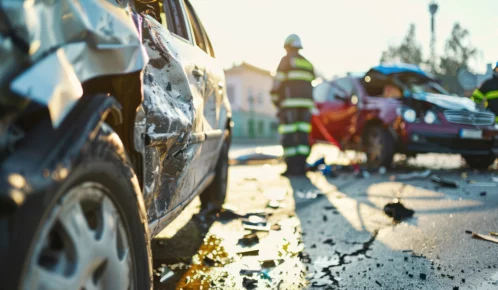After getting involved in a car accident, it’s possible for victims to prove that they weren’t at fault in a few different ways. In car accident cases, the individual who is at fault will need to cover the costs of the accident, including any damage to vehicles and injuries that people sustain. In addition, at-fault parties may also see higher insurance premiums, receive demerit points on their driving records, or face serious criminal charges.
Table of Contents
Why Proving Fault Matters After a Car Accident
Fault is important to determine in car accident cases because most states determine financial liability for vehicle accidents based on who was at fault. These states are known as “fault” states, while some other states use a “no-fault” model.
In states where fault matters in an accident, the individual who caused the accident or their insurer will need to cover the damages resulting from the accident, including any injuries or other damages that other drivers, passengers, pedestrians, or others sustained. The types of damages that liable parties will need to cover may include medical expenses, vehicle repairs, lost wages due to disability and recovery times, and pain and suffering.
Generally, proving fault in car accident cases entails proving that liable parties practiced negligence. If a driver is at fault in an accident, they and their auto accident insurance coverage may pay out any damages sustained. However, proving fault can be challenging for victims in these accidents, particularly if the nature of an accident is complex and involves many aspects.
How to Dispute Fault After a Car Accident
If a person is involved in a car accident, they can prove fault in a number of ways. Depending on what’s involved in a car accident case and the different factors leading up to it, the following are some of the circumstances that can help prove fault and negligence.
The At-Fault Party Clearly Violated Traffic Laws
It’s often easy to prove fault in a car accident if the negligent party obviously violated traffic laws. These violations may include speeding, running red lights or stop signs, or failing to yield for others who have the right of way. A drunk driving accident can also make it easier to prove fault if the at-fault driver was intoxicated at the time of the collision.
If individuals suspect that a traffic violation applies to an accident, they can conduct research into local and state laws through their local Department of Motor Vehicles (DMV) or various online resources.
Although it may be possible to locate information about the laws that apply to an accident, the details are often complex and unclear to many who don’t have experience with the law. If people have certain questions about legal terminology and otherwise have difficulty understanding the law, they may benefit from consulting a motor vehicle accident lawyer.
While many car accident cases don’t involve attorneys, people representing themselves can still educate themselves on the law and determine if it’s possible to clearly prove fault based on traffic law violations. This could help support their claims when filing with insurance companies.
Car Accidents Result from Left-Turn and Rear-End Collisions
If a person makes an illegal left turn or crashes into the vehicle in front of them, they’re normally at fault. Both of these types of accidents are often deadly for the victims, or they can result in serious injuries and costly vehicle damage. Victims in these cases also have minimal room to avert the collision, which makes the liable parties almost entirely at fault.
Specifically, in rear-end collisions, the driver who rear-ends the vehicle in front is most likely to be at fault, as they either follow the vehicle too closely for them to stop in time when the front vehicle stops, or they may be distracted and fail to pay attention to the vehicle in front.
However, some cases may involve a front driver who’s at fault, depending on the specific circumstances. As an example, the front driver may have broken taillights that they neglect to repair, which could fail to indicate to rear drivers that they intend to stop or slow down. Some drivers may also illegally park in a highway lane, causing vehicles to collide with them from behind.
In cases involving illegal left turns, meanwhile, the driver making the left turn likely entered the intersection and made the turn when they didn’t have time to complete it. It’s often easier to prove negligence in these cases because of the location of the damage on the vehicles involved. While the driver making the left turn will have damage to the front of their car, the other vehicle normally has damage on the front right side.
On the other hand, the driver traveling straight in cases involving left turns could be at fault if they ran a red light or stop sign. They may also be at fault if they otherwise failed to give the other driver the right of way when they had it.
Police Reports Support Fault
In some cases, police reports can support fault based on the details that law enforcement records. Police reports may detail whether the allegedly at-fault driver received a citation from the arresting officer, and the officer may include details in the report based on their own findings. All of this information can go a long way in helping support a plaintiff’s claim.
Police reports also frequently include both drivers’ versions of events in addition to the officer’s take. Additionally, police reports could include witness testimony from those who were present at the time of the accident. If witnesses are difficult to reach at a later point, their testimony in a police report may be the only way to get their version of events.
While police reports can be critical in car accident cases, the police don’t always arrive at the scene of an accident. If the police don’t show up and nobody notifies them of the accident immediately afterward, it’s important to contact the police and initiate the generation of a police report as soon as possible. Ideally, the defendant involved would also visit the police station to discuss the incident, but they may not choose to go.
After the police create a report, plaintiffs should check it to make sure it’s accurate. They may be able to fix basic errors pertaining to locations and times, but if the report makes other mistakes such as misidentifying who was at fault, the process of fixing them will be more complex.
It’s important for plaintiffs to keep in mind that other reports may help support their claims, including mechanic reports. A qualified mechanic may be able to provide written details about the nature of the damage that a vehicle sustained and areas of impact.
Determining Fault Based on Negligence
When proving that they’re not at fault for an accident, plaintiffs in car accident cases should understand the different degrees of negligence and how they influence fault.
The two different types of negligence systems that states may use include:
Comparative Negligence
In states with comparative negligence systems, injured parties may still receive compensation if they were partially at fault for an accident. However, the amount of compensation they receive may be lower depending on the level of responsibility shared. States that use this system will determine how much each party is at fault using percentages.
There are three types of comparative negligence that may play into fault, including pure comparative negligence, the 50% rule of modified comparative negligence, and the 51% rule of modified comparative negligence.
13 states currently use the pure comparative negligence model. Using this system, each party involved receives a percentage of fault that determines how insurance companies award compensation. Regardless of the differences in percentages, injury victims may be able to recover compensation as long as they aren’t 100% responsible for the accident. However, if injured individuals’ share of responsibility is too high, the amount of compensation they’re eligible to recover may not be enough to warrant a claim.
Meanwhile, the 50% rule that appears in 12 states only allows injury victims in accidents to recover compensation if they were 50% at fault or less. Another 21 states adhere to the 51% rule, which only awards damages to plaintiffs if they’re 50% at fault or less.
Contributory Negligence
Formerly known as the 1% rule, this particular common law defense establishes that injury victims are only able to recover compensation if they’re entirely free of fault in an accident involving two or more individuals.
Only five states follow this system because of its restrictiveness, with most states instead adopting a comparative negligence system.
What to Do After an Accident to Help Support a Claim
If a person is in an accident and wishes to file a claim for any injuries or other damages resulting from an at-fault party, there are some specific steps they must take to help build their case.
These steps include:
Contacting the Authorities
As mentioned, police reports are instrumental in proving fault in car accident cases. This is why it’s important to contact the authorities immediately after an accident, particularly if anyone is injured. Both police and an ambulance may show up at the scene of the accident.
Seeking Medical Treatment
Another crucial step is to seek medical treatment as soon as possible. Victims may need to visit the hospital due to serious injuries and take the ambulance there, but others may sustain minor injuries or injuries that develop into more serious conditions later.
Even if injuries don’t appear to require treatment, it’s best to speak with a medical professional and undergo an examination. Doctors may discover that superficially minor injuries indicate more serious underlying conditions. The sooner victims seek medical attention, the sooner they can also begin the healing process to help them recover.
Seeking medical treatment also leads to the creation of medical records and other documentation that can help support a car accident claim. Otherwise, failing to seek treatment could not only weaken a claim, but it could also lead to more serious symptoms and complications later.
Collecting All Obtainable Evidence
A wide range of physical evidence can further help support a claim and prove who was at fault.
At the scene of the accident, when possible, individuals can record information such as drivers’ names, phone numbers, addresses, and other contact information. They should also take note of insurance companies, the insurers’ phone numbers, and policy numbers. In addition, individuals should record vehicle makes, models, and license plate numbers. It’s also important to collect the names and contact details of witnesses present at the accident.
Taking photos or recording video footage of the scene and any injuries or damages could also show the fallout of an accident.
Contacting Insurance Companies
Even if an accident isn’t their fault, individuals should notify their insurer of the accident. Most insurance policies include a notification clause that requires people involved in an accident to report it and initiate an investigation.
In the process, insurance coverage may be able to help pay for medical bills and vehicle repairs. Notifying the plaintiff’s insurance company can also help the insurer prepare for contact from the at-fault party and their insurer.
Injury victims should also notify the at-fault driver’s insurance company after receiving treatment and notifying their own insurer. The at-fault party’s insurance adjuster will then begin investigating and negotiating a claim.
Calculating the Value of a Claim
Insurance adjusters may be friendly and appear to be on the plaintiff’s side, but the fact is that they work to get the claimant to agree to the lowest possible payout to protect the interests of the insurer. This is why it’s critical to know the true value of a car accident case.
There are many factors that may contribute to the total value of a case. For instance, property damage could play a part in the form of vehicle repair or replacement costs, along with the value of personal longings destroyed in the accident. Meanwhile, personal injury damages may include medical expenses, lost wages resulting from recovery times or disability, and pain and suffering.
With so many influencing factors, it can be difficult to accurately calculate the damages. With the help of a car accident attorney, claimants may be able to more accurately determine the overall value of their case. Based on this number, they can begin negotiations with insurance adjusters with a specific number in mind.
Consult an Attorney
While many car accident cases may be simple enough to avoid the need for legal counsel, some cases involving high costs and certain complexities may benefit from the involvement of an attorney.
Taking all of these steps can help claimants in car accident cases prove that other parties were partially or entirely at fault for an accident, which can subsequently maximize their chances of recovering full compensation.



